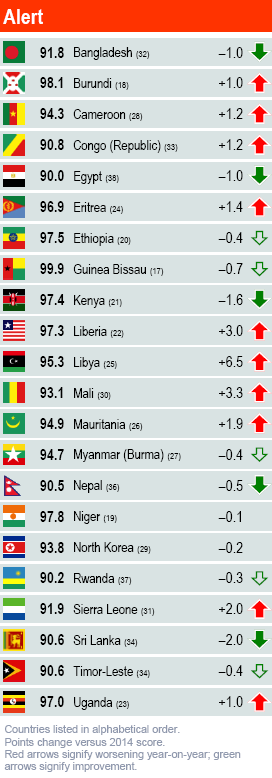BY PATRICIA TAFT
In December 2013 in a tiny village in Guinea, a young child fell ill and died of a disease that would come to define much of the news in 2014. The Ebola virus, previously only known in Central and East Africa, laid ravage to large swaths of Guinea, Liberia and Sierra Leone, three countries that had just begun to recover after years of civil war. Indeed, Liberia and Sierra Leone were featured in last year’s Fragile States Index as two success stories, climbing back, slowly but steadily, from the abyss. Last year however laid bare where years of both national and international attention (or lack of attention, as in the case of Guinea) failed to address some of a country’s most basic needs: a functioning public health system and passable roads.
 In the case of Ebola in West Africa, prior development assistance for infrastructure turned out to be a double-edged sword. On the one hand, the building of roads to connect far flung villages to the capitals and major cities in each country likely contributed to the spread of the disease, as infected individuals often walked for hours on roads to seek assistance outside of their formerly isolated villages. On the other hand, the condition of these roads, which were often built hastily and then fell into disrepair when national governments had neither the money nor the interest in keeping them up, became impassable during the rainy season when they essentially melted back into the jungle. For health care and humanitarian aid workers, this made the task of reaching the sick and dying nearly impossible at times. In an odd twist of fate, however, the very neglect of the national road system by the government may well have ended up saving thousands of lives in Liberia. In multiple reports, including many issued by the FFP from 2010-2014, the government was criticized for their extremely slow pace in connecting counties in the east and southeast of Liberia with the capital. These counties, which were often hotspots of the opposition, were essentially completely cut off from the capital during the rainy season. In several interviews conducted by FFP, individuals stated that they felt more like a citizen of neighboring Cote d’Ivoire than Liberia, as much of their news, food and basic supplies came across that border rather than from the capital. This very isolation, albeit disastrous for a sense of national identity, very likely halted the spread of Ebola to these population-dense counties. And, in turn, may have stopped its transmission across the border into Cote d’Ivoire, although this is largely speculative.
In the case of Ebola in West Africa, prior development assistance for infrastructure turned out to be a double-edged sword. On the one hand, the building of roads to connect far flung villages to the capitals and major cities in each country likely contributed to the spread of the disease, as infected individuals often walked for hours on roads to seek assistance outside of their formerly isolated villages. On the other hand, the condition of these roads, which were often built hastily and then fell into disrepair when national governments had neither the money nor the interest in keeping them up, became impassable during the rainy season when they essentially melted back into the jungle. For health care and humanitarian aid workers, this made the task of reaching the sick and dying nearly impossible at times. In an odd twist of fate, however, the very neglect of the national road system by the government may well have ended up saving thousands of lives in Liberia. In multiple reports, including many issued by the FFP from 2010-2014, the government was criticized for their extremely slow pace in connecting counties in the east and southeast of Liberia with the capital. These counties, which were often hotspots of the opposition, were essentially completely cut off from the capital during the rainy season. In several interviews conducted by FFP, individuals stated that they felt more like a citizen of neighboring Cote d’Ivoire than Liberia, as much of their news, food and basic supplies came across that border rather than from the capital. This very isolation, albeit disastrous for a sense of national identity, very likely halted the spread of Ebola to these population-dense counties. And, in turn, may have stopped its transmission across the border into Cote d’Ivoire, although this is largely speculative.
In either case, though, one of the lessons of the 2014 Ebola crisis was that basic infrastructure projects, like building durable roads, are crucial in post-conflict societies. While not necessarily as “sexy” as other post-conflict efforts, a lack of a viable state infrastructure can be disastrous in both a political sense as well as a humanitarian one. Even in cases where there was a dedicated effort in the aftermath of war towards infrastructure repair outside of the capital, like in Sierra Leone, years of wear and tear later, some roads were just as impassable as those in Guinea, a place that was never the recipient of such international largesse.
To be sure, a quick look at the Demographic Pressures Indicator for each country in the 2015 Index, which is where non-existent or crumbling infrastructure is often revealed, underscores how ill-prepared each nation was to deal with the Ebola crisis. This should serve as food for thought as the international community analyzes the lessons of this outbreak and what can and should be learned in its aftermath. Although the three countries have thankfully been declared Ebola free and are again on the path to recovery, the Ebola outbreak of 2014 showed the world just how vulnerable post-conflict nations remain, even years into their healing.
